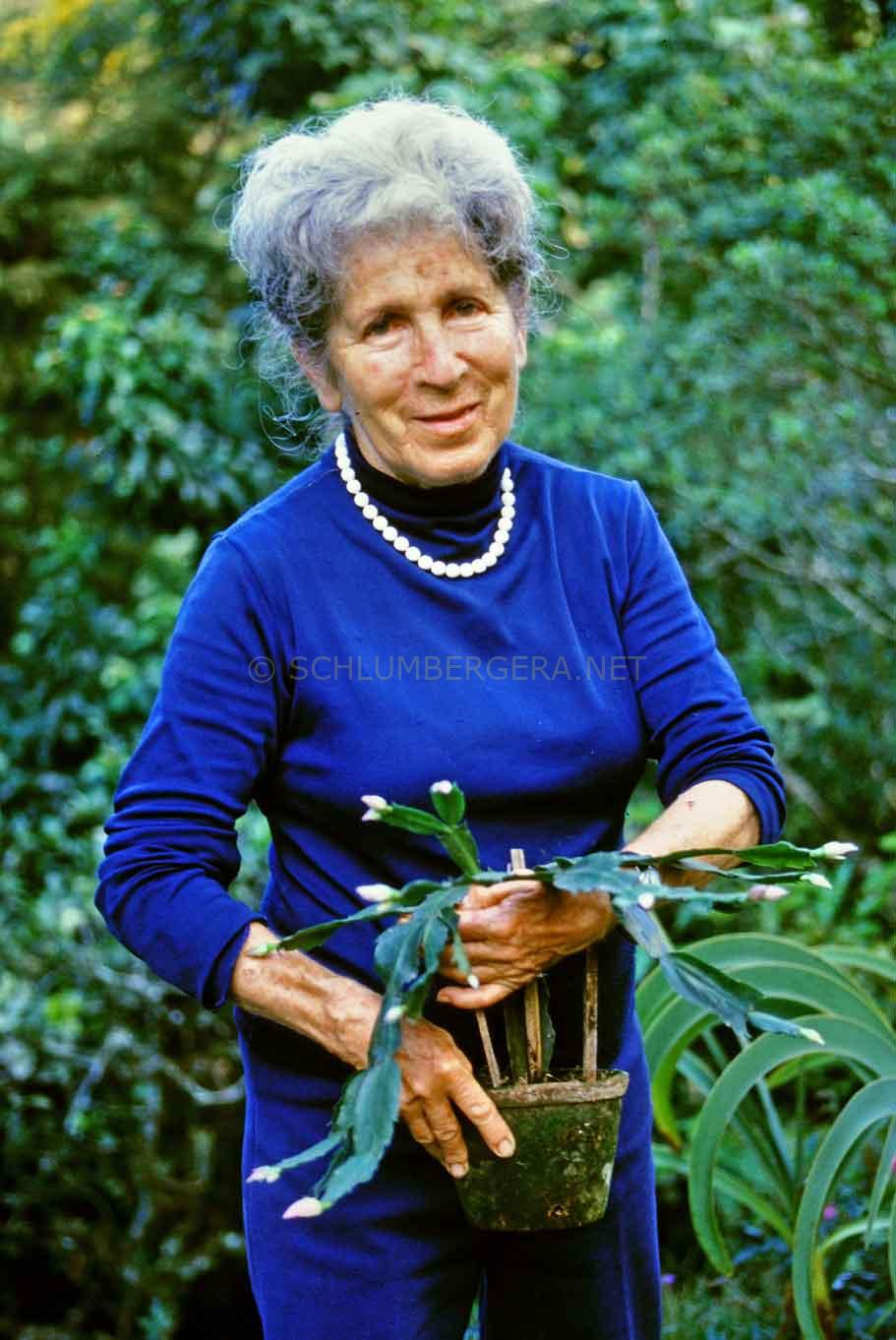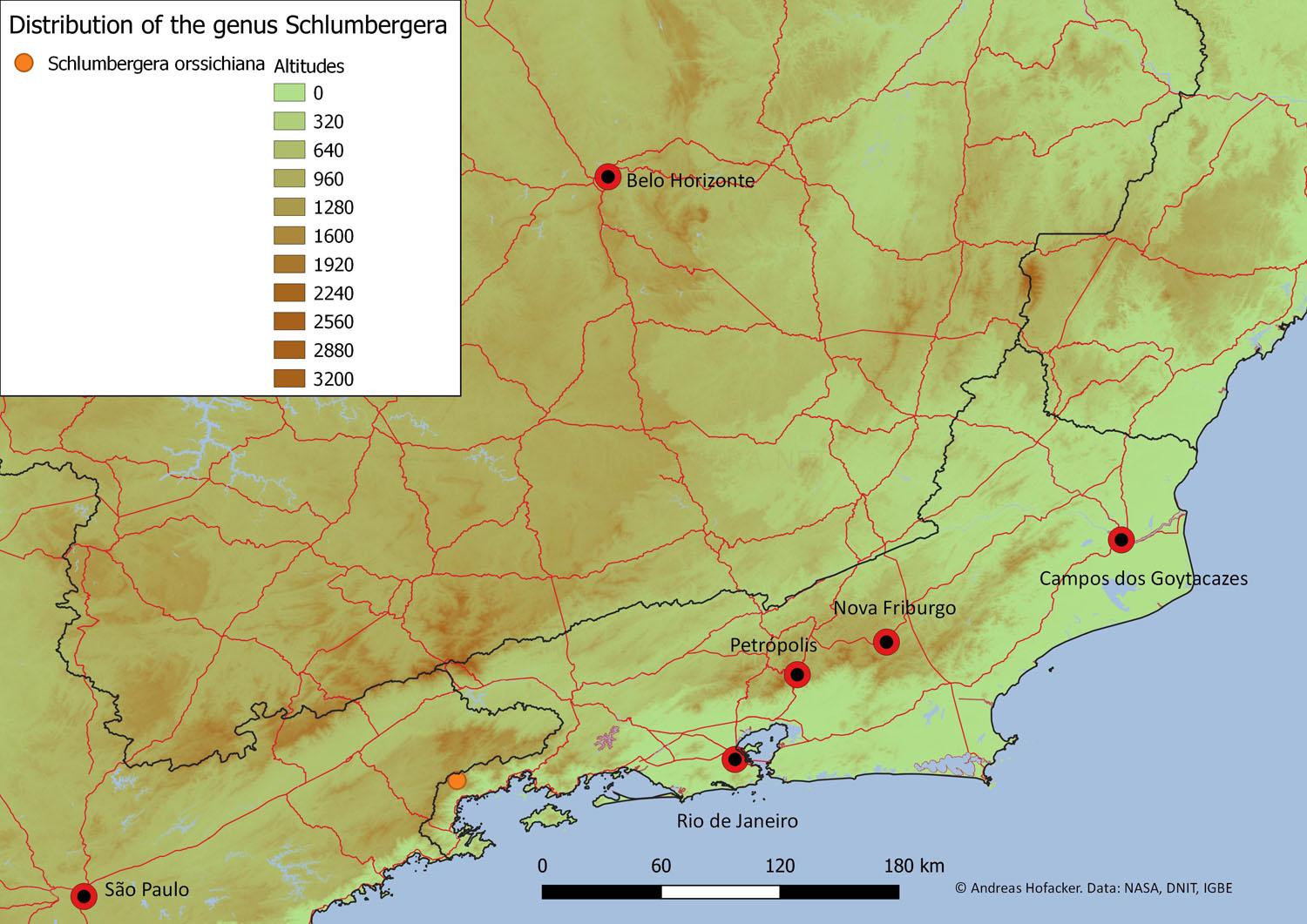Schlumbergera orssichiana
Description:
Phylloclades flattened, 6 cm long and 3.5 cm wide, apical and marginal with forward pointing teeth.
Flowers with a well-developed perianth-tube, zygomorphic, up to 7 cm long, white, rose, red or purple with all intermediates, self-sterile.
Fruit pear-shaped; pinkish to reddish, not ribbed.
Flowering period in northern hemisphere: September-October.
First description:
Bartlott, W.A. & McMillan, A.J.S. (1978): Cactus and Succulent Journal (US) 50: 31.
Origin of the name:
Named in honor of Countess Beatrix Orssich (1909-September 24, 1993) who lived in the city of Teresópolis, Brazil and introduced the plants into culture.
(click to enlarge)

Occurence:
Brazil (Rio de Janeiro), in altitudes between 250 and 1300 m elevation.
(click to enlarge)
Histrorical Clonal Descriptions
Dolly K3 – USA. Jochen Bockemühl, named by Jochen Bockemühl and Ruud Tropper, 2016. (Popponesett KS22 × Jochen KS21W24). Dolly Kölli made the initial cross. The seed was germinated by Jochen Bockemühl in May 2014. When the seedling was one year old, it was raised by Ruud Tropper. Ref.: EPIG 77: 9–11. (2016).
Eckhard KS25 – USA. Dolly Kölli. (Wild Type I × Wild Type II).
Highwood KS22W24 – USA. Dolly Kölli. (Wild Type I × Wild Type II).
Jochen KS21W24 – USA. Dolly Kölli. (Wild Type I × Wild Type II).
Mashpee KS21W5 – USA. Dolly Kölli. (Wild Type I × Wild Type II).
New Seabury KS21W2 – USA. Dolly Kölli. (Wild Type I × Wild Type II).
Popponesset KS22 – USA. Dolly Kölli. (Wild Type I × Wild Type II).
Quashnet KS30 – USA. Dolly Kölli. (Wild Type I × Wild Type II).
Unnamed K1 – USA. Jochen Bockemühl. (Popponesset KS22 × Jochen KS21W24).
Unnamed K2 – USA. Jochen Bockemühl. (Popponesset KS22 × Jochen KS21W24).
Wild Type I – Brazil. Large, 9 cm by 9 cm slightly zygomorphic flowers have white center that suffuses to carmine tips, opening very wide. Color varies depending on the time of year bloom occurs. The short tube is white, with white filaments, deep yellow anthers and magenta style having 6–8 stigma lobes. Pericarpels are light green, c. 1.2 cm long and 5–6 angled, differing from the smooth pericarpels of S. truncata. Ripe fruit is yellow-green to white, whereas S. truncata has pink to reddish ripe fruit. Growth is close to S. truncata. Growth habit is very pendant with large, wavy phylloclades 5–7.5 cm long by 3.2–4.5 cm wide, with margins having 2–3 sharply pointed, sometimes curved dentations. Often an extra dentation appears near the apex of a segment. This trait is also evident in S. orssichiana hybrids. Distribution: Countess Beatrix Orssich received the plants from an orchid collector without precise locality. It was said that they were collected at the Morro dos Três Picos in the state of Rio de Janeiro. Mrs Orssich supplied the initial two wild forms from Brazil. These initial plants were grafted once they arrived in Europe. It is believed the rootstock was virused, which is where the issue of viral infection originated in the early specimens. Fortunately, the two forms were crossed and virus free seedlings produced.
Wild Type II – Brazil. Slightly smaller flower size. Coloration is the same as Wild Form I. Phylloclades are also similar differing only in being slightly smaller. All other characteristics identical.
Wild Type III – Probably same as Wild Type I. Heavily virused, smaller than Wild Type I. Could not be hybridized with Wild Type I.
Pictures:
(click to enlarge)
-

Schlumbergera orssichiana ‘Reading’, photo: Ruud Tropper -

Schlumbergera orssichiana ‘Poponosset’, photo: Ruud Tropper -

Schlumbergera orssichiana ‘Popponesset’ -

Schlumbergera orssichiana KS22 x KS21W24 K5, photo: Ruud Tropper -

Schlumbergera orssichiana ‘Dolly’ , photo: Ruud Tropper -

Schlumbergera orssichiana KS22 x KS21W24 K2, photo: Ruud Tropper -

Schlumbergera orssichiana KS22 x KS21W24 K2, photo: Ruud Tropper -

Schlumbergera orssichiana ‘Jochen’, photo: Ruud Tropper -

Schlumbergera orssichiana ‘Jochen’, photo: Ruud Tropper -

Schlumbergera orssichiana ‘Jochen’, photo: Ruud Tropper -

Schlumbergera orssichiana ‘Jochen’, photo: Ruud Tropper -

Schlumbergera orssichiana ‘Jochen’, photo: Ruud Tropper -

Schlumbergera orssichiana ‘Quashnet’, photo: Ruud Tropper -

Schlumbergera orssichiana ‘Eckhard’, photo: Ruud Tropper -

Schlumbergera orssichiana ‘Eckhard’, photo: Ruud Tropper -

Schlumbergera orssichiana GN06_1, photo: Ruud Tropper -

Schlumbergera orssichiana GN06_1, photo: Ruud Tropper -

Schlumbergera orssichiana GN06_1, photo: Ruud Tropper -

Schlumbergera orssichiana ex B. Orssich, photo: Ruud Tropper -

Schlumbergera orssichiana ex B. Orssich, photo: Ruud Tropper




